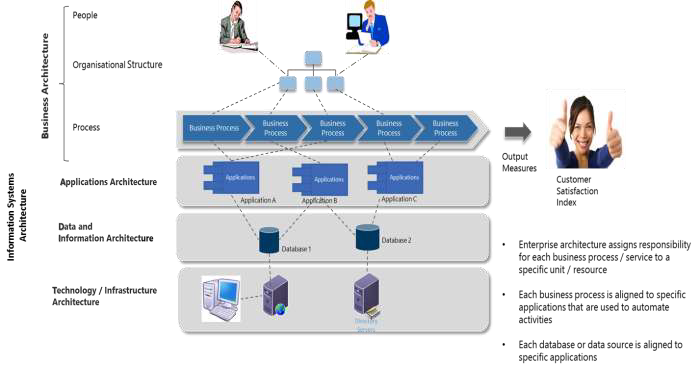Enterprise Architecture Domains
As stated above, enterprise architecture seeks to address business requirements that would bring added value to the organization and its target customers. To achieve this, leading practice has identified five interlinked domains that make up enterprise architecture. These are Business, Information, Data, Application, and Technology Architecture domains.
The modified Government of Rwanda Enterprise Architecture Framework has combined some of the closely aligned domains so that the view is made up of the following three core domains:
- Business Architecture – This is the apex architecture domain as it sets the requirements for the other supporting one. Within the Business Architecture domain, the organization’s strategic mandate is defined and this sets the foundation for business requirements that the other architecture domains seek to address. Within the business architecture domain, therefore, the following elements are defined: Business strategy, governance, organisational structure, Business Rules, key business processes, business locations and services. These set the direction for the organisation which IT seeks to enable. The following domains which have a technical focus in nature, therefore, are designed to enable the business architecture objectives.
- Information Systems Architecture – the processes that are defined within the business architecture domain need both human and system interventions to execute. In some cases the processes are fully automated while in some the mix of manual and automated processes occur. It is therefore important that relationship between business processes / services and systems be clearly defined.
This association of the process with systems is reflected both within the business and application architecture domains.
The application domain itself has a close association with the data and information architecture domains. Thus the application uses data from the databases and either presents or transmits via some protocol.
Because of this close association between the three domains, The Application, Data and Information domains have been grouped together within the Information Systems Architecture Domain.
- Application Architecture – Defines and documents artifacts for the Application systems in each environment, their interactions, and their relationships to the core business processes of the organisation. It documents the user interfaces, applications and their attributes, associations between different application etc.
- Data Architecture – defines the Data sources, usage of the data, users of the data, owners of the data, location of the databases, reporting tools, data classification etc.
- Information Architecture – Defines the Information Lifecycle Management, documents, information transfer protocols, data classifications etc.
3. Technology Architecture – This documents the hardware & software capabilities required to support deployment of business, data, and application services.
Enterprise architecture seeks to bring seamless alignment of the abovementioned domains to deliver value to the customer. Thus in documenting end to end architecture for each entity, an association will be made between business services and business process which in turn will be mapped to the application that automate the processes (as well as the role or actors that are responsible for its execution).
Similarly, every application has to map back to the data sources where it stores and retrieves data from.
The infrastructure that support the systems has also to be mapped to the resultant technologies. This seamless alignment is depicted in Figure 4.


No Comments